A lot of folks don’t like coyotes but I’m in a different camp. I have great admiration for their adaptability, hunting skills, intelligence and communication abilities. Over the past few years I’ve had many opportunities to observe their behaviors on Antelope Island which has made me an even bigger fan of this amazing canid. To watch a coyote hunt is a fascinating experience.
This post is meant as a documentation of the opportunistic feeding tendencies of the species rather than as a showcase for technically perfect photos. Getting clear shots of any mammal on the ground (as opposed to perched or flying birds) is a rarity because of all of the grasses, sunflowers, sagebrush, rabbitbrush and moth mullein the photographer has to shoot through on the island. So there’s lots of “stuff” in front of the coyote in some of these shots and a couple of them are sizeable crops but I think their prey tendencies are documented reasonably well by the images.
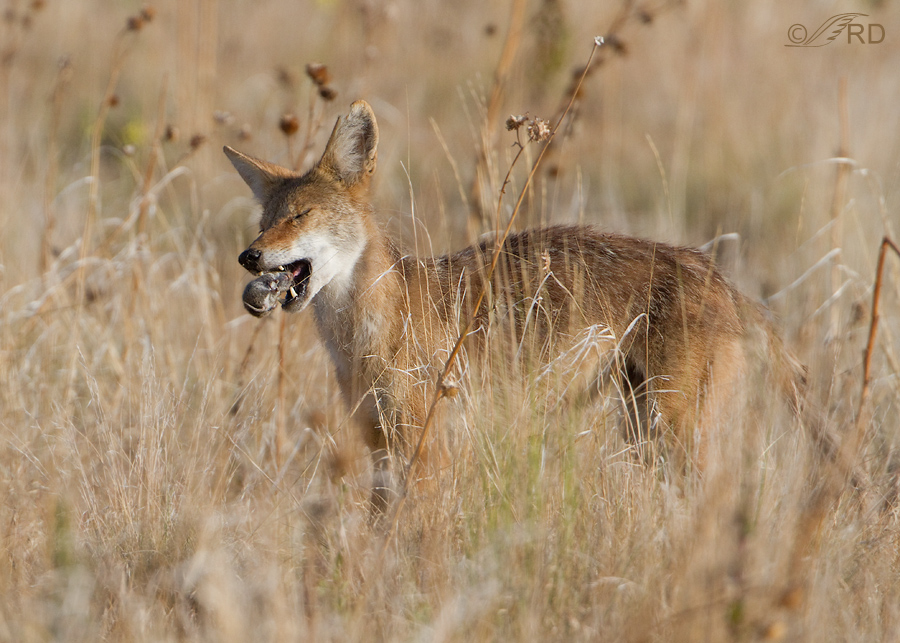
1/2000, f/7.1, ISO 500, 500 f/4, 1.4 tc
Coyotes eat a lot of voles – prodigious numbers of them in fact. I’ve seen a single animal catch and consume 4-5 voles in the same area within just a few minutes and I’ve seen it several times.
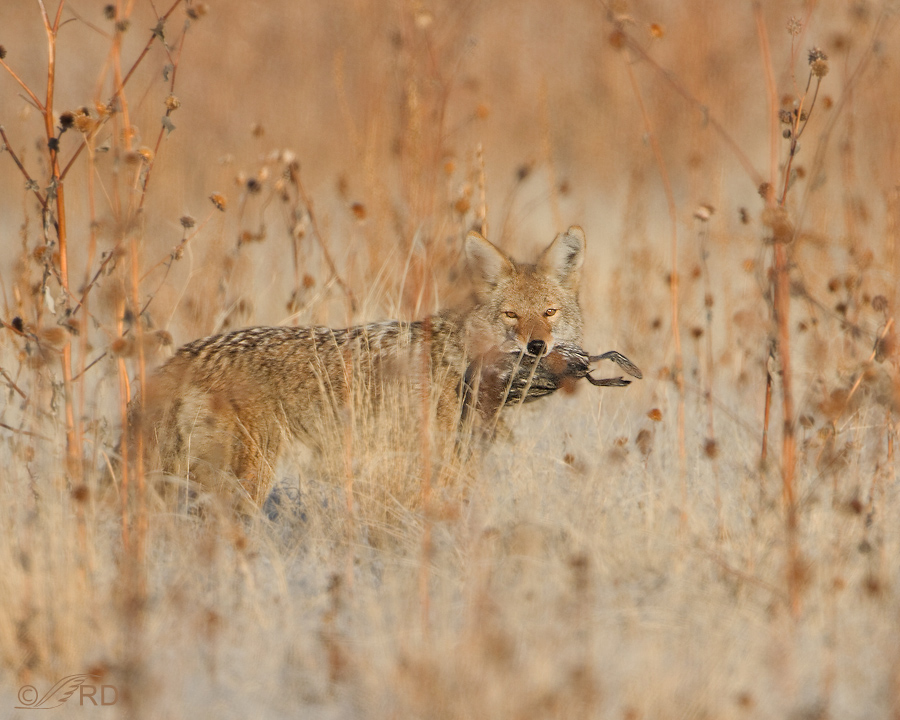 1/1000, f/6.3, ISO 500, 500 f/4, 1.4 tc
1/1000, f/6.3, ISO 500, 500 f/4, 1.4 tc
But they’ll also take birds when they can catch them. This coyote was returning from the lake shoreline with an unusual prize – some kind of waterfowl. From the position of the leg attachment at the back of the body I’d guess it to be one of the grebe species.

1/500, f/7.1, ISO 400, 100-400 @ 320mm
Here a coyote has scavenged what’s left of a duck carcass along the causeway to the island. I suspect the duck was originally killed by either a Peregrine or Prairie Falcon as we would often see them during winter feeding on their waterfowl prey along the causeway. They would eat their fill and abandon the rest. Several coyotes seem to have learned that it’s worth it to brave all the close vehicular traffic along the causeway for the chance at some of these leftovers. The background in this image is ice that has been blown up onto the shore by the cold north wind.
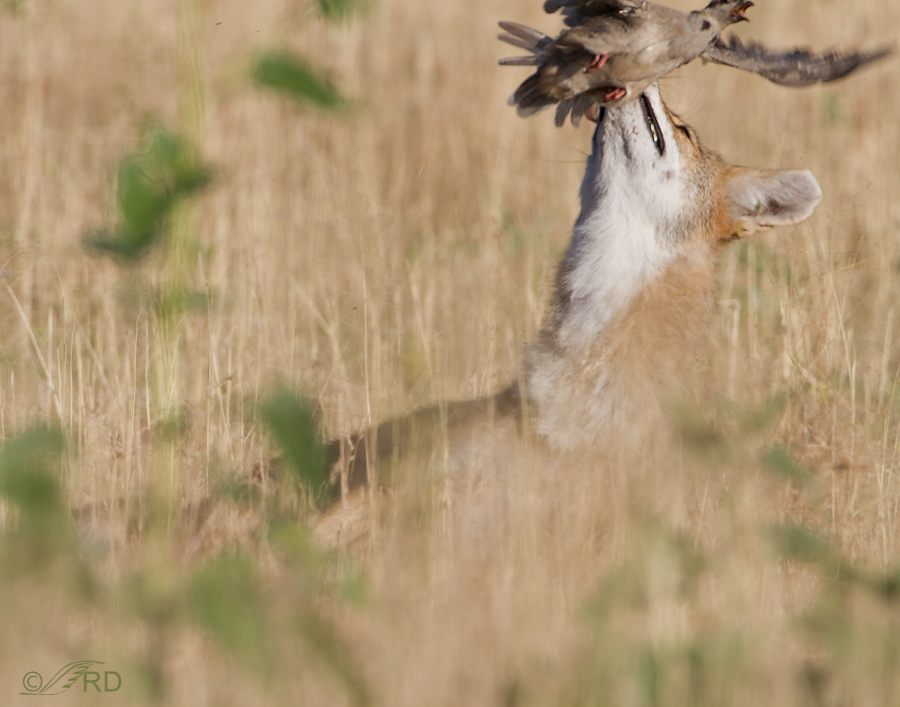
1/1600, f/8, ISO 500, 500 f/4, 1.4 tc
Here a young coyote came oh so close to catching a first year Chukar as it flushed. We watched the coyote stalking a group of these young birds thinking all along that it had no chance to catch any of them. It very nearly succeeded but all it actually got was a single feather that came floating down in the next frame.
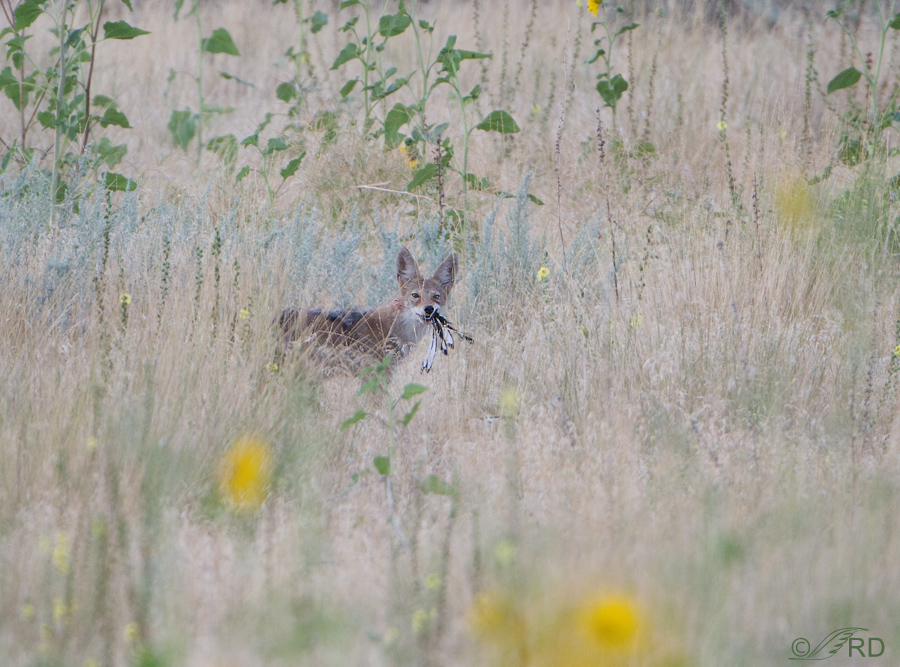
1/1250, f/5.6, ISO 640, 500 f/4, 1.4 tc
This young coyote is enjoying a magpie breakfast among the sunflowers. This one surprised me as I would expect the cagey magpie to be difficult prey for a coyote.
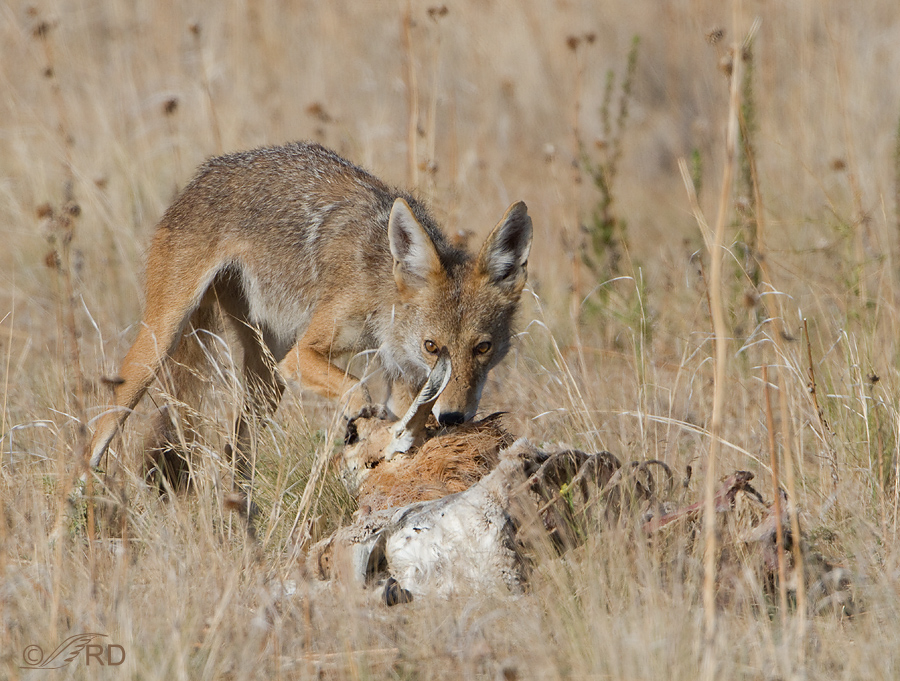
1/2000, f/8, ISO 500, 500 f/4, 1.4 tc
This coyote is feeding on a winter-killed Pronghorn. I’ve never witnessed a coyote actually hunting or stalking any of the larger mammals on the island (mule deer, pronghorn or bison). In fact, the only actual aggression I’ve seen between coyotes and larger mammals out there was when a gutsy pronghorn chased a couple of adult coyotes all over the north end of the island. I’ve documented that experience here.

1/2000, f/7.1, ISO 500, 500 f/4, 1.4 tc
But the staple for coyotes on the island is, without question, voles. Voles, voles and more voles for dessert. I’d estimate that 95 to 98% of the time when I’ve seen them with prey it’s been a vole. One thing has surprised me – despite the fact that the island is literally jumping with both jackrabbits and cottontails I’ve never witnessed a coyote eating or even hunting one. Perplexing…
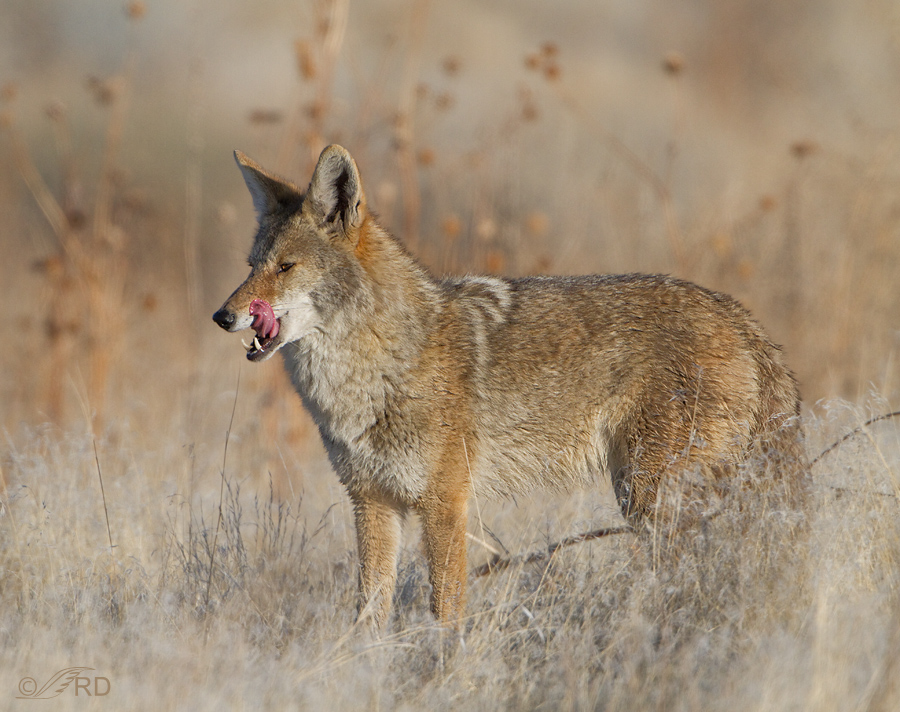
1/3200, f/6.3, ISO 640, 500 f/4, 1.4 tc
Like most canids, coyotes nearly always lick their chops after eating.
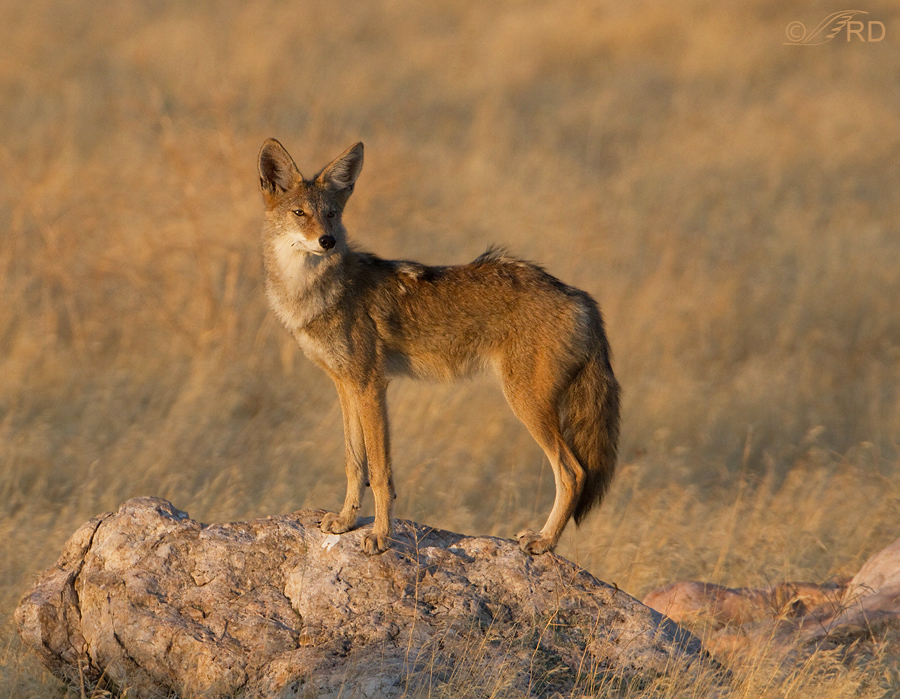
1/1600, f/6.3, ISO 640, 500 f/4, 1.4 tc
Yes, I’m a great admirer of the coyote – one of the major success stories of evolution.
In March of this year Governor Gary Hebert signed into law the euphemistically named “Mule Deer Protection Act” which more than doubles the bounty for killing a coyote in Utah – from the previous $20 per pair of coyote ears brought in, to $50. The stated goal is to kill 20,000 of them in the state. They can be killed all year-long, there is no quota on how many can be killed nor are there regulations regarding how they can be killed.
This law was passed despite the facts that even wildlife officials are skeptical of the advisability and effectiveness of the law, trapping and poisoning are inhumane and inherently dangerous and the negative ecological impacts of removing such an important predator from natural systems are obvious. Funding a $7.5 million program over 10 years on a wasteful and ineffective coyote-killing program at the same time that our state parks are bleeding to death with never ending budget cuts makes my blood boil.
Once again I am embarrassed and disgusted by the ignorance and short-sightedness of Utah’s legislature. I had hopes that Governor Hebert would have the wisdom, foresight and political pluck to veto the bill. Silly me…
Ron


Ron, what a beautiful post and just stunning photos. I’m amazed at the shots you’ve captured here. I wish more people realized that coyotes do, indeed, prefer rodents as a dietary staple. Perhaps the violent actions toward them would abate just a little, if people understood the coyote’s important ecological role. Then again, I realize it’s hoping for too much that facts might actually sway the misguided wildlife policy you describe.
My heart repeatedly breaks for the fate of our unprotected and targeted wild animals. I don’t eat any meat for various reasons, and am glad this contributes, however minutely, to the health of the animals and ecosystem. btw, there was an article recently in a Marin County paper about the effectiveness of dogs in deterring coyote attacks. If livestock is really at the root (probably is), I wish more communities would use Marin’s system as a model, for both coyotes and wolves: http://bit.ly/NDb3IY
Thanks very much for an especially interesting comment and link Ingrid. I know that some folks in Montana have been using Great Pyrenees dogs to protect their livestock too. It sure makes more sense to me than these misguided killing policies.
I realize that if the coyote/livestock issue could be universally remedied without lethal policies, there would still be people hankering to shoot them. But, at least there would be less plausible justification.
Fantastic sequence of images Ron! The shot with the ice background and the finale image are flat out gorgeous in my eyes.
I’m around coyotes enough to both enjoy and respect their presence. They exhibit enough familiar dog behaviors to make them somewhat understandable to me, but are unquestionably wild at the same time. What isn’t understandable to me is the strategy of “managing” them through a ridiculously broad campaign waged by anyone/anywhere, rather than a well thought out, targeted effort put together by informed professionals. If indeed there is a problem to start with. The real problem might be that coyotes have been slow to grasp the concept of unlimited giving to our local electorate.
We agree again Mike, this time on two counts – our favorite shots of this post and the “real” reason coyotes are always given the short shrift by politicians.
Ron,
The coyotes in your images look fairly healthy compared to the coyotes I see around Tucson. Most are very skinny and seem to have a tough life. Sad to hear about the program to kill more of them and just plain stupid to call this effort something like the “Mule Deer Protection Act”. But any policy that promotes shoot first and ask questions later has never made any sense to me. An interesting coyote post with some wonderful pictures.
Jim
Thanks very much Jim. I sure hope you’re surviving the heat down there. It’s been too hot here so I can only imagine…
You are so correct. Oh, and by the way, I haven’t eaten beef or lamb for years. I decided I could not be a partner in the demise of western predators back when I was in college. If everyone would just cut their red meat consumption, the wild west would be grateful.
Tana, I don’t eat lamb either but I just can’t give up beef so I fight the good fight on my blog instead…
Thanks for sharing. Great captures.
I appreciate your comment Earl.
A great post again, Ron. Very informative, and I love the photos. That last bottom photo is a study in the majesty of the coyote.
Thanks Bob. I’m especially glad you liked that last shot.
Thank you for the pics. I wish they could have a bigger audience. Down Teasdale way, we have no more coyotes, no more yipping in the night, and so many more rabbits running in herds all over the place. It is so troubling that the coyote has been named public enemy number one when they have so little to do with deer populations declining. Education is the key. We must keep up with the misinformation. One such group is Utah Environmental Congress, which tries against huge odds to educate the people of Utah about forests, predation, and loss of habitat. Bob Brister is one of the people who runs it.
You’re absolutely right Tana – the key is education and coyotes have very little to do with declining deer herds. It’s my opinion that the larger push for the “Mule Deer Protection Act” is really to protect sheep and calves running on public lands but that “reason” is less defensible politically so they deliberately misled when they named the act.
These are incredible photos, thank you SO MUCH!!!
Coyotes are incredible creatures…. they seem to have survived attacks against their species for a long time. They are very intelligent, thank goodness.
I inherited a treasure of Ranger Rick magazines in 1983 and spent all summer reading them. There was information about culling coyotes with poison and traps. I was 11 years old and horrified; I’d never had a pet, they reminded me a lot of dogs, and I love dogs.
There was an interesting article on the NPR website about coyotes in Chicago – catching “vermin” etc. See here: http://www.npr.org/blogs/krulwich/2010/12/08/131876027/60-wild-coyotes-patrol-chicago-and-occasionally-stop-at-convenience-stores
Also: http://www.dailycoyote.net/?p=1331 – a gal adopted a coyote (Charlie) after it’s parents/siblings were killed for killing livestock in Wyoming
Thank you Nicole. We have abused coyotes for much too long and I wish it would stop but I’m not holding my breath.
An interesting link you provided on NPR – amazing to see that coyote running through the Chicago streets. The dailycoyote link is one I’ve stumbled upon before – it’s even mentioned on the Wikipedia article on the coyote.